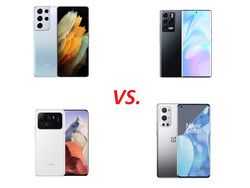Not only in the field of photography Current flagships not only record videos in UHD quality and HDR with 60 frames per second, but also allow 8K videos with 24 or 30 frames per second at 7,680 x 4,320 pixels.
We take this as an opportunity to take a look at the Android-camp. Samsung often enjoys the reputation of being the first choice for video recordings in the Android segment, but Xiaomi and OnePlus have also upgraded their camera sensors considerably.
Our video comparison features: the Samsung Galaxy S21 Ultra, Xiaomi Mi 11 Ultra, OnePlus 9 Pro and the ZTE Axon 30 Ultra.
| Samsung Galaxy S21 Ultra | ZTE Axon 30 Ultra | OnePlus 9 Pro | Xiaomi Mi 11 Ultra | |
|---|---|---|---|---|
| Camera (main sensor) | 108 MP (Samsung HM3, 24 mm, 83°, 0.8 µm, f/1.8, OIS,8K video, Pro video mode) | 64 MP (f/1.6, OIS, 8K video) | 48 MP (f/1.8, OIS, 8K video) | 50 MP (f/2.0, 24mm, 1/1.12", 1.4µm, 8K video) |
| 8K | 24 fps | 30 fps | 24 fps (HDR) | |
| Ultra HD | 24 fps, 30 fps, 60 fps | 30 fps (HDR), 60 fps | 30 fps (HDR), 60 fps, 120 fps | 30 fps (HDR), 60 fps |
| Full HD | 24 fps, 30 fps, 60 fps, 120 fps, 240 fps | 30 fps, 60 fps, 120 fps, 240 fps | 30 fps, 60 fps, 120 fps, 240 fps | 30 fps, 60 fps, 120 fps, 240 fps, 480 fps, 960 fps, 1920 fps |
| Software Version | RP1A .2000720 .012 .G998BXXXU3AUG4 | 11.0.11 | 12.2.7.7 | 12.5.10 (CN) |
Video recording with the smartphone cameras during the day
Our comparison smartphones stabilize the videos both optically and electronically. In addition, the flagships partly want to analyze movements via AI algorithms and thus compensate for blur.
All test sections focus on the main optics for video. Since the additional lenses often deliver a significantly worse picture quality, we do not go into these. Switching between the lenses during a recording is only supported by the OnePlus 9 Pro and Samsung Galaxy S21 Ultra.
Video quality
Unlike in the field of photography the differences in videos in UHD quality are clearly pronounced in daylight. A bit of backlight is enough (scene 2) to make the Axon 30 Ultra, but also a OnePlus 9 Pro to overstrain. Exposure, sharpness and dynamics are not really right here. The Mi 11 Ultra reveals some weaknesses in the field of focusing, but the points of criticism of the ZTE and OnePlus smartphones that we mentioned are solved much better. We also like the color reproduction best overall.
As with the Test photos, the Mi 11 Ultra has problems with the sharpness of very close objects, such as our kitten scene. Here, the OnePlus 9 Pro and Galaxy S21 Ultra perform better. The white balance of the Axon 30 Ultra is completely off, although the sharpness is okay.
Overall, the video recordings of the Galaxy S21 Ultra are the best in our eyes. The Samsung phone displays the subject with high contrast and is relatively sharp, and the details are also reproduced well. However, Samsung's flagship also reveals distortions with every camera swivel and even in daylight, short image noise is repeatedly seen.
However, 8K videos are not the Korean smartphone manufacturer's strength. The Galaxy S21 Ultra loses the good sharpness of the UHD video recordings. In contrast, more details are revealed by the Mi 11 Ultra and the OnePlus 9 Pro. However, none of the four smartphones manages to give our kitten enough sharpness.
The Axon 30 Ultra again stands out negatively in terms of color reproduction in 8K mode. Videos with the ZTE phone are clearly too warm and somewhat reddish.
Stabilization
The most appealing stabilization at UHD quality with 30 fps is offered by the Galaxy S21 Ultra - in the test video, after initially walking, we walk quite briskly until we start to run. Even when walking fast, the picture is still comparatively smooth and the focusing is successful over long stretches of the video
Quite the opposite occurs with the Axon 30 Ultra. The ZTE flagship tracks the focus quite slowly, so subjects look very blurry when walking. The Galaxy S21 Ultra is also much more agile and faster when focusing between close objects.
The OnePlus 9 Pro and the Mi 11 Ultra solved our fast movements better than the Axon 30 Ultra. However, we do not see the two flagships on Samsung's level in terms of quality. The autofocus is slower in both smartphones than in the Galaxy S21 Ultra, and the video stabilization is not as good.
In videos with UHD and 60 frames per second, movements look a bit more unnatural in all comparison devices than in 4K30 because they are displayed slightly faster. The competition catches up with Samsung in terms of stabilization. Even an Axon 30 Ultra performs better compared to the Galaxy S21 Ultra at 30 fps.
Overall, we still see the Galaxy S21 Ultra slightly ahead in terms of stabilization, also because Samsung solves the exposure best. The test video of the OnePlus 9 Pro is also quite good, though.
As in the case of image quality, OnePlus and, to a slight extent, Xiaomi can offer decent 8K video stabilization. Samsung leaves points behind here, and the Axon 30 Ultra also provides very shaky recordings.
Video recording with the smartphone cameras in darkness
In low-light video recordings, the Mi 11 Ultra has the lowest noise level and the best sharpness, and the illumination is also quite appealing with the Xiaomi phone. Clearly blurrier and interspersed with many image errors are the results of the Galaxy S21 Ultra. Nevertheless, videos with the Samsung phone are well lit.
Qualitatively between the videos of the Mi 11 Ultra and Galaxy S21 Ultra we see the OnePlus 9 Pro. The cheapest model, the Axon 30 Ultra, performs visibly worse than the competition. Neither the image sharpness nor the illumination are good in low light. The ZTE flagship also produces noise relatively quickly.
Sound quality of the flagship smartphones during videos
In quiet surroundings, the microphones of all flagship phones prove to be sensitive enough to record even quiet voices intelligibly. A clear and low-noise audio recording is particularly provided by the Galaxy S21 Ultra and the Mi 11 Ultra. On the other hand, with the Axon 30 Ultra voices sound a bit tinny and scratchy. Also with the OnePlus 9 Pro we sound less clear than with the Samsung and Xiaomi smartphones.
Outdoors, with increasing wind noise, the S21 Ultra and Mi 11 Ultra in particular weaken. These two smartphones can compensate for light gusts of wind quite reliably, but wind noise is very present overall - especially in the Galaxy S21 Ultra.
OnePlus audibly filters out wind better and thus delivers a better sound recording outdoors. The Axon 30 Ultra reduces wind noise even more - ZTE really does a very good job here. While loud wind noises are suppressed, the ZTE phone records voices somewhat unnaturally, which makes the OnePlus 9 Pro the winner in this discipline.
Conclusion of the video comparison of the flagship smartphones
In the area of photography our camera test revealed a close race between the Xiaomi Mi 11 Ultra and the Samsung Galaxy S21 Ultra. If the focus is now placed exclusively on moving pictures, the favorites expand to include the OnePlus 9 Pro.
There is no clear winner in the field of videography. Samsung is too bad in low light and too susceptible to wind noise.
In daylight, all smartphones deliver good to very good results in UHD quality, but a Galaxy S21 Ultra has the best overall package. The Mi 11 Ultra struggles a bit with image sharpness and the stabilization cannot keep up with the Samsung phone at 30 fps. Although the OnePlus 9 Pro has slight deficits in picture quality (UHD), it stabilizes shakes very consistently in our test video. Considering the sound susceptibility of Xiaomi's flagship in terms of wind noise, the OnePlus 9 Pro will probably be slightly ahead of the Mi 11 Ultra.
However, for those who often want to film family gatherings in poor light situations, the Mi 11 Ultra should be the first choice before a Galaxy S21 Ultra. The Mi 11 Ultra has the lowest noise level and the best sharpness in low-light video recordings. Samsung's phone is visibly noisy earlier than Xiaomi's flagship in lower light.
As expected, the wheat is separated from the chaff in 8K videos. The Axon 30 Ultra falls further behind in this discipline, but the Galaxy S21 Ultra is not convincing here either in terms of details or stabilization. Especially since Samsung only offers a comparatively limited field of view under 8K. In our opinion, OnePlus offers the best overall video experience in this segment.
As in all camera tests from notebookcheck.com, all original files are also included in this video comparison to enable comparability and individual opinions. You are welcome to express your opinion in our comments section below the test.
Prices & Availability
The Xiaomi Mi 11 Ultra is available in the global version for about 1,200 Euros (~$1424), including at Amazon. The Widevine L1 and LTE Band 20 support as well as the low prices in China make the CN version of the Mi 11 Ultra very attractive. The import prices of the flagship start at around 780 Euros (~$926), including at Trading Shenzhen.
The S21 Ultra is available from Notebooksbilliger or Amazon (with 36-months manufacturer warranty) for about 950 Euros (~$1127).
The OnePlus 9 Pro is available from many online retailers, including notebooksbilliger.de or amazon.de. Prices are currently around 800 Euros (~$949).
The ZTE Axon 30 Ultra 5G is available for 750 Euros (~$890), currently only in the ZTE store.








































